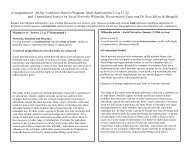Strange Scholarship in the Wegman Report - Get a Free Blog
Strange Scholarship in the Wegman Report - Get a Free Blog
Strange Scholarship in the Wegman Report - Get a Free Blog
Create successful ePaper yourself
Turn your PDF publications into a flip-book with our unique Google optimized e-Paper software.
<strong>Strange</strong> <strong>Scholarship</strong> <strong>in</strong> <strong>the</strong> <strong>Wegman</strong> <strong>Report</strong> V1.0 09/26/10<br />
2.3 Literature review<br />
The entire text of WR pp.23-27 is shown <strong>in</strong> W.3, with <strong>in</strong>terspersed<br />
commentary. Many Memes, Themes, Errors and Biases appear,<br />
unsurpris<strong>in</strong>g, s<strong>in</strong>ce it summarizes <strong>the</strong> error-laden WR Appendix C and<br />
Bibliography. These <strong>in</strong>clude multiple misunderstand<strong>in</strong>gs of basic physics<br />
and <strong>the</strong> strong <strong>in</strong>nuendo:<br />
―The variables affect<strong>in</strong>g earth‘s climate and atmosphere are most likely to be<br />
numerous and confound<strong>in</strong>g. Mak<strong>in</strong>g conclusive statements without specific<br />
f<strong>in</strong>d<strong>in</strong>gs with regard to atmospheric forc<strong>in</strong>gs suggests a lack of scientific rigor<br />
and possibly an agenda.‖<br />
This comb<strong>in</strong>es culpable ignorance with an <strong>in</strong>s<strong>in</strong>uation of wrongdo<strong>in</strong>g,<br />
Theme-N❹, Meme-e❶.<br />
In any case, Conclusion, Recommendations and Executive Summary often<br />
ignore <strong>the</strong> Literature review and <strong>the</strong> Summaries on which it is based. So<br />
does some of <strong>Wegman</strong>‘s testimony. Aga<strong>in</strong>, at a glance, this looks like<br />
normal scholarship, but is not. It is just ano<strong>the</strong>r part of <strong>the</strong> façade.<br />
2.4 Reconstruction – strange graphs<br />
WR §4 implements #1 of <strong>the</strong> 2 ma<strong>in</strong> missions for <strong>the</strong> WR: ratify <strong>the</strong><br />
statistical attack by MM, especially as seen <strong>in</strong> MM05x.<br />
WR, p.7:<br />
―To this end, Committee staff asked for advice as to <strong>the</strong> validity of <strong>the</strong><br />
compla<strong>in</strong>ts of McIntyre and McKitrick [MM] and related implications. …‖<br />
The WR is written by statisticians supposedly to evaluate MM-vs-MBH,<br />
statistically. One would expect this WR §4 to provide that, but <strong>in</strong>stead, it<br />
reiterates why MM must be right and MBH wrong, reproduces various<br />
MM graphs and strongly promotes a distorted version of a 1990 IPCC<br />
graph discarded by 1992, W.4.2. W.4.2-W4.4 collect various related<br />
strange graphs and graphical contradictions <strong>in</strong> one place. The reader might<br />
want to exam<strong>in</strong>e <strong>the</strong>se. Statistical arguments are difficult to follow, but<br />
graphs make strong impressions, and can easily be mislead<strong>in</strong>g.<br />
Recomput<strong>in</strong>g <strong>the</strong> MBH-decentered PCA with proper center<strong>in</strong>g is <strong>the</strong><br />
obvious task, as suggested by Cressie, and <strong>in</strong>dependently done by Wahl,<br />
Ammann (2006), whose follow<strong>in</strong>g chart is discussed more <strong>in</strong> W.8.4. The<br />
PCA decenter<strong>in</strong>g only affects a small fraction of <strong>the</strong> data for <strong>the</strong> early time<br />
period. They computed <strong>the</strong> red curve with that fixed, some data problems<br />
20<br />
fixed, but also with correct selection procedures for <strong>the</strong> number of proxies.<br />
If all that is jargon, do not worry.<br />
Just look at <strong>the</strong> follow<strong>in</strong>g chart and compare <strong>the</strong> (red) l<strong>in</strong>e, done <strong>in</strong> 2006,<br />
with <strong>the</strong> orig<strong>in</strong>al (grey) version done <strong>in</strong> 1998.<br />
This whole fuss is about <strong>the</strong> difference between grey and red. Of<br />
course <strong>the</strong>y differ slightly, for good reason. Does this matter?<br />
Wahl, Ammann (2006)<br />
The WR does not do this, Meme-f❶, Theme-N❹, but <strong>the</strong> topic is discussed<br />
<strong>in</strong> some detail <strong>in</strong> [WEG2006c, pp.10-15]. They cite Wahl, Ammann<br />
(2006) only <strong>in</strong> a footnote, to discredit it. Later, <strong>in</strong> response to Rep. Stupak,<br />
we f<strong>in</strong>d:<br />
[WEG2006c, p.11]:<br />
―Ans: The Wahl and Ammann paper came to our attention relatively late <strong>in</strong> our<br />
deliberations, but was considered by us. Some immediate thoughts we had on<br />
Wahl and Ammann was that Dr. Mann lists himself as a Ph.D. co advisor to<br />
Dr. Ammann on his resume. As I testified <strong>in</strong> <strong>the</strong> second hear<strong>in</strong>g, <strong>the</strong> work of<br />
Dr. Ammann can hardly be thought to be an unbiased <strong>in</strong>dependent report.‖<br />
That simply does not address <strong>the</strong> statistics issues claimed to be <strong>the</strong> purpose<br />
of <strong>the</strong> WR. As shown <strong>the</strong> Page tally §2.7, <strong>the</strong> WR actually provides zero<br />
useful new statistical analysis of <strong>the</strong> hockey stick, for which peer-reviewed<br />
articles were promised <strong>in</strong> 2006, A.1.3. They have yet to appear.



